In order to perform your best, you need to move well in a biomechanical way and a mobility practice will help you do exactly this.
Can you get into the correct position on every exercise or drill? Do you have the ability to move with proper form and alignment? Your Mobility is certainly part of the answer, which is why every athlete needs to develop an effective mobility practice if they want to maximize results and perform their best.
In this post, you will learn:
• What is Mobility and its importance to performance.
• How to effectively increase your mobility.
• How to assess your current mobility.
What is Mobility?
According to Gray Cook, creator of the Functional Movement Screen, Mobility is the combination of range of motion in every joint structure and the healthy flexibility of your soft tissue (muscles, tendons and fascia).
Now, while Cook’s factual, cut and dry definition is very accurate, it does not stress the importance of Mobility for athletes. So, here’s a more poetic description of Mobility from Erwan Le Corre, the creator of MovNat, a training discipline that focuses on natural movements.
Mobility places you in optimal position. -Erwan Le Corre
Exactly. In accordance with the notion that ‘form equals function,’ mobility is the ability to get into the exact position and move in such as way that will create your best performance.
Mobility Questions:
Let’s actually look at your own Mobility to see what we are really talking about. Kneel down on one knee and hold a pole to your back- have the pole touch your pelvis, rib cage (behind your heart) and the back of your head. Next, lunge forward and keep the pole in contact with those three points on your body. Now, look in a mirror and answer this question: Can you achieve ten degrees of Hip Extension? In other words, does your thigh bone move back at a 10 degree angle while your spine remains vertical? Does your kneecap vertically clear your pelvis?
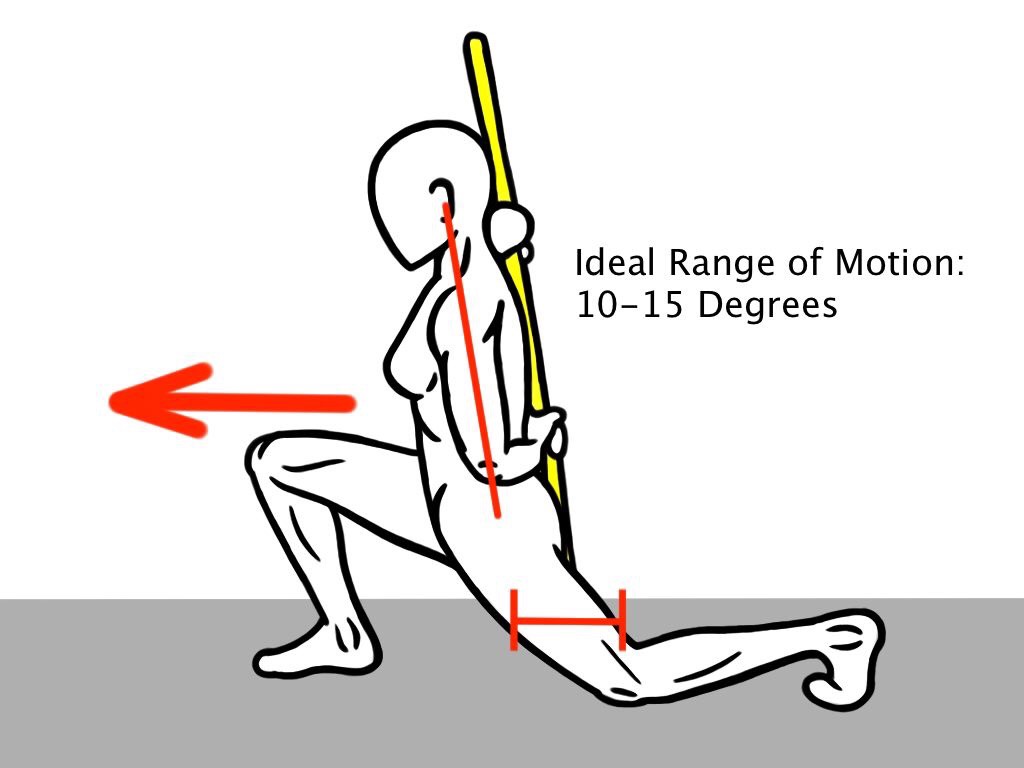
Full Hip Extension is an essential component to your gait and the way you walk or run. If you are not able to perform this move, then you are lacking ‘mobility’ in your gait. Or better put, every time you take a step, you are not moving in an ‘optimal’ way. So, please don’t think about training for a marathon, as you will most likely do more harm than good. Yet, now that you’re reading this, you’ll soon understand Mobility’s role in performance and you can address what needs to be addressed in order to run a marathon!
Defining a Role
Mobility is your ability to physically get into the right position and accurately move in an intended pattern or also referred to as your biomechanical efficacy in alignment and movement. In other words, do you have the range of motion, flexibility and neuromuscular coordination to perform an exercise or task with proper form? You need to answer this question with a ‘yes’ if you want to perform your best.
Importance of Mobility
As stated previously in the post about Alignment, Form is Function, meaning the alignment of your body (form) will dictate how one performs (function) and Mobility is an essential component to this formula because it dictates whether or not you can even create the ‘correct form.’ Therefore, your mobility will dictate how well you can make any movement, complete specific tasks and, in general, perform at an optimal level.
Example of Mobility
As a strength coach for a football team, I focus on mobility with the lineman because when they are fighting in the trenches, the team that gets lower to the ground will have better leverage usually control the line of scrimmage. Therefore, it’s important that these linemen learn to get their hips low because that will drop their center of gravity and give them more leverage. The lineman who can’t get low will most likely be the one who gets beats. Conversely, a lineman with good mobility will play with an advantage.
Mobility Does Not Equal Flexibility
It’s important to note that Mobility is comprised of three factors, which are collectively represented by the degree of which one can accurately maintain proper alignment through a specific movement pattern. Mobility is not your ‘flexibility’ as Gray Cook clearly points out. Mobility is the combination of flexibility of the soft tissue, the range of motion of every joint and the neuromuscular coordination involved in creating the specific movement.
In a post on MobilityWOD.com, Gray Cook defines Mobility and also addresses the harm that occurs when coaches or trainers misinterpret mobility as flexibility to their players and clients because it implies the answer for addressing a lack of mobility is purely stretching, which is untrue as that solution neglects the associative neurological patterning and joint limitations within one’s movement. In other words, stretching will not improve the way that you ‘create’ movement in a holistic sense because the flexibility of one’s soft tissue is only part of Mobility. The other components that are essential to mobility are the range of motion at each joint and the neuromuscular coordination of every movement pattern. To elaborate, a person may be ultra flexible but still lack mobility when it comes to a specific movement patterns because they may have limitations at the joint or they may process the movement neurologically in an ineffective manner.
For example, when I teach my football players a weightlifting exercise called the Deadlift, many of them are very loose in their hamstrings. Yet many of these players have severe lack of hip mobility due to the combination of sprinting some much in practice and then sitting all day in class. The sprints in practice will tense up and tighten the Hip Flexors, which is a flexibility issue. Then the sitting will slowly remold the active range of motion of the hip socket over time and lead to a restricted range of motion. On top of that, sitting will also ‘turn off’ the glutes (hip muscles) and affect the neuromuscular coordination when trying to perform a Deadlift.
The Three components of Mobility:
• Flexibility of the Soft Tissue
• Range of Motion at the Joints
• Neurological Coordination of Movement Patterns
If you remember that Mobility is a combination of these three components, you will develop much more effective Mobility practice that bring you a step closer to performing your best.
Developing a Mobility Practice
Now, you may be wondering where you should start in regards to developing a Mobility practice. Or maybe you are not totally convinced that you need to develop a Mobility practice. In either case, let’s start by assessing where you are at in regards to your current level of Mobility.
First: Assess
Use the following Exercise Evaluations to assess your Mobility of in these movement patterns. You can also use specific movements and skills that you are a major part of your sport or training, such a Three-Point Stance in football, your running form or a weightlifting exercise like the Snatch, Squat or Power Clean.
Note: in regards to these later example of exercises or sports specific skills, you must know the correct alignment in all of the positions and movement patterns before you start evaluating and practicing. More plainly put, you should know the fundamentals of a Power Clean before you make it a focal point in your mobility practice and training. Otherwise, you may only be moving in the wrong direction- both figuratively and literally.
Basic Mobility Assessments:
• Wall Slide for Shoulder/Thoracic Spine Mobility
• Knee Pull and Heel Pull
See the exercises and instructions at the bottom of this post.
Second: Address Limitations
Once you’ve accurately assess mobility in regards to your biomechanics or in comparison with sports specific skills, it is time to address any and all limitations to forge improvements. This can be as easy as one, two, three…
Three Basic Steps to Improve Mobility:
1. Soft Tissue Therapy
2. Restore Full Range of Motion
3. Retrain the Neurological Patterning of Movement
Soft Tissue Therapy
The first step towards improved mobility is addressing the limitations within the Soft Tissue itself. Knots, adhesions and the build up of scar tissue will restrict the functionality of the soft tissue and not allow it to lengthen or contract as it should. These physiological ‘snags’ ultimately disrupt how one moves on a micro and macro level as the body is force to reconfigure movement patterns to compensate for these limitations.
Further Explanation
Whenever there is tightness or hardness in your soft tissue, there are muscle fibers that are locked in a closed or shorten positions because of either tiny micro-tears, neurological patterning, dehydration or a combination of all three. These locked fibers form knots and adhesion while larger micro-tears will use the build of scar tissue to provide support and protection. In all three cases, the process of ‘protection’ will prohibit the soft tissue from lengthening and contracting as it should, which consequently creates a compensation pattern in how a person moves – sometimes to a small degree and at other times a large degree. Regardless, any degree of compensation ultimately affects performance because form equals function and limited form will lead to limitations in function.
An analogy of this limiting process can be illustrated with a woman’s stocking that has a hole in it. When something snags the fabric of the stocking, a hole soon appears in the stocking that will later transform into a run and will only worsen the more that she moves around. Coincidently, any knot, adhesion or build up of scar tissue parallels as a hole in a woman’s stocking, which will surely create a new ‘tightness’ or ‘hardness’ in the soft tissue and ultimately leads to a compensation pattern or a ‘run in a stocking’ in ones movement. These newly formed constraints will thwart that person’s ability to move with correct alignment and eventually create deviations or compensations in their movement. Not good.
Soft Tissue Therapy techniques are different ways that people can eliminate the knots, adhesions and scar tissue that will create problems and clean up one’s soft tissue. Here are some of the most common and practical soft tissue therapy techniques that anyone can use in their Mobility practice.
Examples of Soft Tissue Therapy Techniques:
• Rolling: Using Foam Rollers, Trigger Point Rollers, PVC Pipes, Barbells and more
• Balling: Rolling with various balls, including tennis, lacrosse, golf balls and more
• Massage – Using Hands, Fingers, Forearms and even Feet
For a basic introduction to Foam Rolling – CLICK HERE
Goal of Soft Tissue Therapy
The primary objective when practicing soft tissue therapy is restoring the ‘softness’ back to your tissue. In other words, whenever you have tightness, hardness or tension in your body, you need to address that area with the intention of turning it back into softness.
All hardness or tightness in your soft tissue is there to protect a weakness caused by overuse, direct impact or an overloaded movement.
Natural Process
It’s important to note that the accumulation of knots and adhesions is completely normal. In fact, it’s part of your bodies natural way of healing itself and these knots are bound to show up in every athlete’s body who is in a training program because training is the continual process of overload, break-down and adaption. In other words, effective training is the habitual process of breaking the body down to rebuild itself stronger.
Additional objectives of Soft Tissue Therapy is to improve circulation through damaged tissue and reduced inflammation on a cellular level, both of which quicken the tissue rebuilding phase and shortens the recovery period. In other words, soft tissue therapy helps you to return to training faster and allows for more opportunities to improve your performance.
Reap the Good
The main benefits of a soft tissue therapy practice are restored length and an improved sliding quality of the contractile tissues that create movement. Knots, adhesions and the build up of scar tissue will lock your muscles into a shorten, locked or static position and also can restrict the speed and length that these tissues can contract or lengthen. In both cases, a physically limit how you move is formed on a micro level that will eventually spread to a macro level with regards to movement and performance.
Too Sore to Move
You ever get so sore after a heavy day of squatting that you could not bend your legs at all? That’s because there are millions of little adhesions trying to prevent further damage to millions of micro-tears by inducing a pain response (soreness) when prompted to move. Consequently, those micro-tears will also create a macro limitation as you may spend the entire day on your couch unless you start practicing some soft tissue therapy.
Immobility Grows Over Time
How many senior citizens do you know that can touch their toes? Or even stand up straight for that matter? Immobility will only grow over time, which is why it’s important to practice mobility on a daily basis, especially when you are feeling sore! Remember soreness is a byproduct of your body breaking down on a micro-level, which is okay. But cultivating a habit of immobility due to soreness is a slippery slope for every athlete.
Developing the mobility practice will safeguard the healthy structure of your muscles on a cellular level.
One of the main reasons that senior citizens may appear so immobile is that they have actually lost muscle fibers over the years. Yes, muscle fibers may have dissolved in the bodies of our grandparents because they have continually learned to move in shorten ranges of motion.
Muscle Fibers Disappear
Biomechanist Katy Bowman will be one of the first one to tell you that if you do not practice movement through a full range of motion, that your sarcomeres (muscle fibers) that are not used will slowly dissolve within the body. This is commonly seen in women who wear high heels for years on a daily basis. Their calves will gradually shorten since sarcomeres (muscle fibers) literally dissolve into other sarcomeres because the calf never fully lengthens. A foot in high heels is a foot that is constantly in a shorten range of motion and there are consequences too. You can learn more about this phenomenon in Bowman’s book, Move Your DNA. Until then, start practicing mobility work on a daily level-especially if you are a woman who wears high heels!
Restoring Range of Motion
After a healthy dose of soft tissue therapy, the next step in your mobility practice would be restoring the range of motion of your joints through movement, including stretching.
Start with gentle or passive movements because we do not want to create further with explosive movements or ballistic stretches that can over stress weaknesses (micro-tears) in the soft tissue. Remember that inside all of the tightness in our soft tissue lies some type of weakness that is trying to heal and repair. Give these muscles fibers time to adapt and recover. So, ease into movement and gradual increase the speed or intensity in which you move to increase your range of motion. In other words, build up to a ballistic stretch like Leg Swings and add speed, weight or intensity in increments.
On top of that, abrupt movements that are common to dynamic stretching can also induce your sympathetic nervous system, which is where fight-or-flight response lies. Stimulating the sympathetic nervous system will create a certain level of tension in the body that would counter our mobility efforts.
What does stretching and mobility progression look like? It looks like starting on the ground and moving simply at first. Stretching with a strap, performing slow movements and staying physically relaxed with deep breathing are helpful and make this an opportunity to ‘re-learn’ how your body moves.
The Zen concept of Beginners Mind is useful when practicing mobility work because we take our ability to move for granted and rarely do we really place our full attention on how we move. Therefore, your mobility practice is our chance to truly listen to our bodies and learn movement all over again! Plus, the more that you approach movement from a new perspective, the more competent you will eventually come in movement, recovery, maintenance and performance.
Skilled athletes are aware of the messages that their bodies send them because they take the time to listen.
The more you listen to your body and place awareness on your biomechanics and how you move, the more effective your mobility practice will become and the more results you can generate from your training.
To learn more about Soft Tissue Therapy – CLICK HERE
Stretching vs Movement
A lot can be said about stretching and movement as forms of mobility exercises, but here’s a condensed expose on both. When people stretch using the PNF technique of ‘contract and relax,’ much flexibility and neuromuscular wiring is restored to tightened soft tissue.
At the same time, movement, especially in the eccentric (lengthening or negative) phase has been proven to yield tremendous results in improving mobility. For example, just try lowering down into a squat position several times as you hold onto a bar or wall. Move slowly and relax. You will notice a great deal of improvement in your mobility after several reps.
Use eccentric movements to simultaneously restore flexibility of the soft tissue and expand the range of motion in each joint.
Move and Stretch
Combining movement and the PNF stretching technique is very impactful in improving mobility and also relatively easy to do. Simply start a movement, such as the squat, and at the deepest or fullest possible range of motion add in the PNF ‘contract/relax’ technique.
Move and Stretch Together: Perform a series of contract/relax cycles in the targeted muscle group at the maximum range of motion.
Practice combining the PNF technique in these stretches:
• Supine Stretches for the Posterior Chain with strap
• Shoulder Flexion against wall
See these exercises at the bottom of this post.
Neurological Patterning
The next step in your mobility practice will be to retrain how your body neurologically produces movement patterns. What does ‘neurological pattern’ actually mean? It’s the sequential way your neuromuscular system sends messages to map out or coordinate your movement. For example, when you raise your arm, an entire neurological pattern was used to create that movement even though you may not have even put much thought into it. Movement is wired into our neuromuscular system like a computer’s motherboard is wired. The good news for us is that neurological patterning is a malleable and adaptable process unlike a motherboard. The bad news is that it takes deliberate thought and effort.
Retraining your current neurological patterns takes practice and it may also will require you to ‘think differently’ about how you move. Your current neurological patterning of movement has already been form and is deeply embedded in your neuromuscular system. These patterns will continue to be your default programming until you introduce and master new alternative.
Quick exercise: take off your shoes off and socks. Now, try to move just your pinkie toe. For most people, this is a difficult task because modern shoes bond and constrict our pinkie toes until the point that we lose the ability to effectively neurologically communicate with the motor units that can move that toes. Now, see how long and how much effort it will take you to get your pinkie toe (and no other toe) to move. This is a barometer of how long it takes to retrain some of your movement patterns.
Why Retrain Movements
Retraining yourself to move with new neurological patterns is key to developing ‘good’ mobility because it affirms your ‘ability’ to move as intended. Let’s say that you improve the flexibility of your soft tissue and the range of motion at your joints, it does not mean that you will move with correct alignment or proper form unless the movement may not be mapped out by your neuromuscular system just as a trail in the woods does not exist until people blaze a path.
Mastery of any movement or sports specific skill must be mapped out and refined over time by your neuromuscular system.
Patterns Under Stress
As previously mentioned, you will never throw a curve ball without developing the neurological pattern for that specific skill. Additionally, becoming a curve ball master will take a certain amount of practice. More importantly, your ability to perform this skill of throwing a curve ball will be impacted by the circumstantial stresses.
Imagine that it is the bottom of the ninth inning, runners are in scoring position and you want to throw a curve ball. Your nervous system may be overloaded with the stress of the situation, which will compromise your ability to throw a curve ball unless the neurological patterning of this movement skill is deeply engrained into your neuromuscular system through exact repetition.
Load (weight) and fatigue are stressors that will affect your ability to perform a specific skill as they may interfere with your neurological patterning and compromise your performance.
Loaded Mobility
Consequently, your mobility will also change under load because of how your neuromuscular system will respond. For example, you may be able to lay on your back and pull your knee up into your chest, which would seem like ideal hip mobility (flexibility and range of motion) for a squat. But when you get onto your feet (and worse off, load yourself with a heavy barbell), your body will process the movement differently. In fact, it may seem as if you have no hip mobility at all when you try to squat with a heavy load because of how your neuromuscular system is responding to the added stress. This is why you need to train the neuromuscular system in regards to mobility while under incremental amount of load.
You will also need to develop your mobility while under stress by practicing specific movement patterns with various incremental loads. Loads progress from partial bodyweight (lying or kneeling on the floor) to full bodyweight (standing or hanging) to weighted (Using equipment such as barbells or more).
Repetition: Mother of Skill
The more that you consciously practice a movement with proper form, the deeper that pattern becomes embedded into your neuromuscular system and the more automatic that specific skill becomes. This process is the reason that numerous NBA players can instantaneously knock down jump shots with no thought at all. In fact, professional athletes have developed a certain level of mastery through many hours of practice, which is why execution of specific movements are vitally automatic. If you are interested in learning more about this skill mastery, check out Malcolm Gladwell’s book, Outliers, where infamously proclaims that it will take 10,000 hours of practice to become world class at something.
Practice Mastery in these Mobility Exercises
• Hip Matrix
• Ankle Matrix
• Spiderman Lunge
See these exercises at the bottom of this post.
Greasing the Groove
Now, take your mobility and training to the next level with this fitness ‘hack’ that people like Tim Ferriss and Zach Even-Esh practice. This hack is called ‘greasing the groove’ and it helps develop mastery of a given skill.
Here’s how to do it:
• Pick a specific skill you want to master, such as the Olympic Snatch or a jump shot.
• Practice the movement frequently through the day in small sets.
• Perform 1-5 repetitions at a time and aim for a total of 100+ repetitions per day
You will be able to notice a considerable increase in efficacy as well as efficiency in that specific skill within a week and considerably more mastery after 3-4 weeks when combined with training the movement under various loads.
Grease the groove with these two movements:
• Lateral Lunge and Reach
• Squat and Rotate
See these exercises at the bottom of this post.
Putting It Altogether
Now, let’s recap this blueprint to Mobility! It’s important to understand the essential components of what Mobility is and how it can be improved. Otherwise, we all might be wasting a lot of time in the gym and not getting anywhere close to the results that we really want from our training, which is not the intention here.
Recap-
So, let’s list out the main points to remember:
Mobility is important to performance and longevity because-
• Mobility is our ability to move with correct alignment and form equals function.
• Mobility will provide the biomechanical space and leverage that maximize our efforts on every movement we make and contributes to our best possible performance.
• Adequate Mobility will reduce compensation strategies in movement and place the appropriate amount of stress on the correct cells/tissues and reduces the risk of injury in the long run.
How to improve your Mobility:
Start with Soft Tissue Therapy-
• Eliminate knots and adhesions that will disrupt our movement patterns and stress our biomechanics
• Assist the natural healing process of repairing micro-tears on a cellular level.
• Address all tight or hard areas and make the soft tissue soft once again.
Add Movements and Stretching
• Increase the Flexibility (Length) of the Soft Tissue (Muscles, Tendons and Fascia)
• Restore the Range of Motion at each Joint in every possible direction.
• Learn what proper biomechanics look like!
Grease the Groove
• Practice specific Movement Patterns and incrementally add load.
• Be critical aware of your alignment as you move through these patterns.
• Use bands or structures (holding onto a wall or bar) to help move smoothly and correctly.
• Practice in small sets (1-5 repetitions at a time) and at a high frequency (aim for a total of 100+ reps per day for each movement pattern you want to master.)
Lastly, measure your progress. Take some pictures of how you move now in a few designated movement patterns, such as the ones mentions above, and compare how you move after 3-4 weeks and after 6-8 weeks of practicing a comprehensive mobility routine.
It’s important to track progress in order to assess what works and also as a way to add some positive reinforcement to your life by acknowledging the effort you put forth and the growth you’ve achieved!
Remember that success is measured by what you overcome and the peace of mind that you create for yourself. It can be a fun too.
Enjoy the journey and keep getting better!
_____________________
PreHab Exercises for Mobility:
Evaluations Exercises-
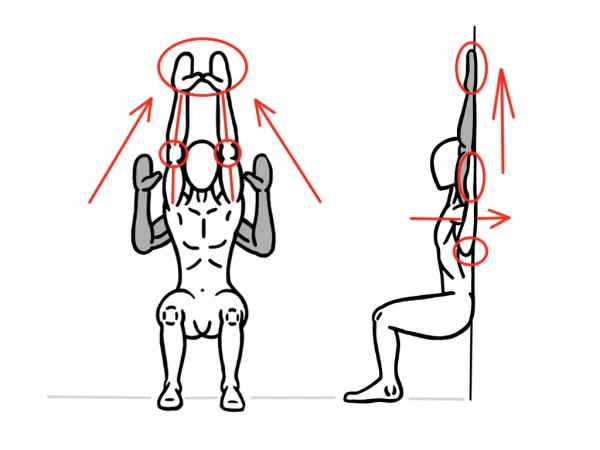
Wall Slide for Shoulder/Thoracic Spine Mobility
• Start is a squat position with your back against the wall.
• Hold your arms out to the side and press the your elbows and backs of your wrists into the wall.
• Simultaneously press your lower back and head flat against the wall.
Now, slide your hands up the wall as high as possible without letting your lower back or head come off the wall. Attempt to touch your thumbs together overhead with straight elbows as the hands maintain contact with the wall. If you can successfully execute this exercise with correct form, you have a good level of biomechanical mobility throughout the anterior aspect of your shoulders and thoracic spine.
If not, start to address the range of motion of your shoulders and thoracic spine while performing soft tissue therapy on the connecting muscle groups (chest, lats, trapz and more) and practice this movement on a daily basis to see change in your mobility.
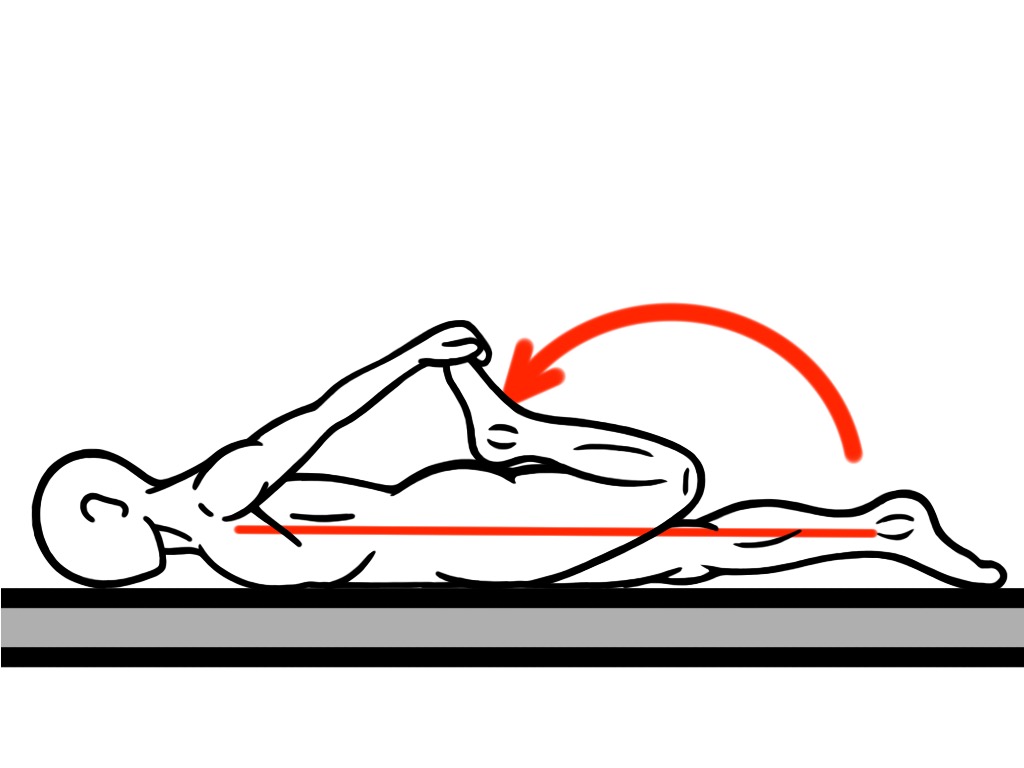
Heel Pull on the Floor
• Lie on your stomach in a straight alignment from head to toes.
• Squeeze your thighs together and bend one knee as far as you can.
• Next, reach back with the same side hand and grab the heel. Gently pull the heel towards your body and attempt to touch the heel to your hips as you keep the front of your hips and chest pressed into the floor.
If you can touch the heel to your hips while keeping the hips and both sides of your chest evenly pressed into the floor, then you have a good level of mobility through your quadriceps and hip Flexors.
If not, start to address the range of motion in your hip extension and knee flexion while performing soft tissue therapy on your quadriceps and hip flexors and practice this exercise on a daily basis in order to create a change in your mobility.

Knee Pull on the Floor
• Lie on your back in straight line alignment from head to toes.
• Pull one knee up into your chest and direct the kneecap towards your heart.
• Press the opposite knee and heel into the ground.
If the pulled thigh can touch your stomach and the kneecap points directly at your heart while your other leg remains flush on the ground, then you have a good level of mobility in hip flexion, which is beneficial in squatting and lunging.
If you cannot complete this movement as prescribe, you should start to perform soft tissue therapy on your Glutes, back and thighs while practicing this movement on a daily basis and other movements, such as pigeon pose, to aid the range of motion in your hips.
Mobility Exercises and PNF Stretches:
Posterior Chain Stretches with Strap
Shoulder Flexion against a Wall
Ankle Matrix against a Wall
Hip Matrix
Spiderman Lunge
Squat and Rotate
Lateral Lunge and Reach
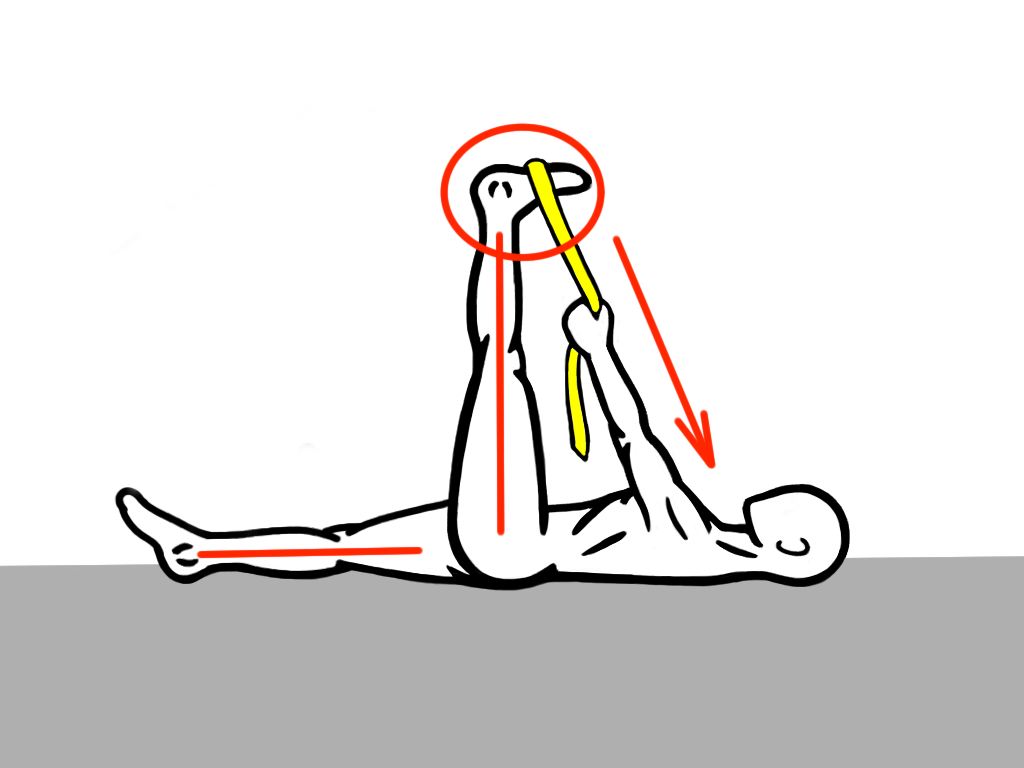
SUPINE SAGITTAL STRETCH-
TARGET: Glutes, Hamstrings, Calf and Foot in a Sagittal (Forward) line of action, which is greatly responsible for the push-off phase of your gait.
POSTION: Lift one leg straight up towards the sky with a strap or towel wrapped around the arch of the foot. Position the heel directly over the hip socket if possible. If not, keep the leg vertically aligned with the hip socket and the shoulder.
ACTION: Contract for a 5-count with one-fourth of your strength and attempt to pull the heel back to the floor as you hold it in place with the strap. Next, relax for a 10 count as you hold the leg. Repeat this Contract/Relax sequence two more times and continue to hold the stretch until you can feel the muscles release.
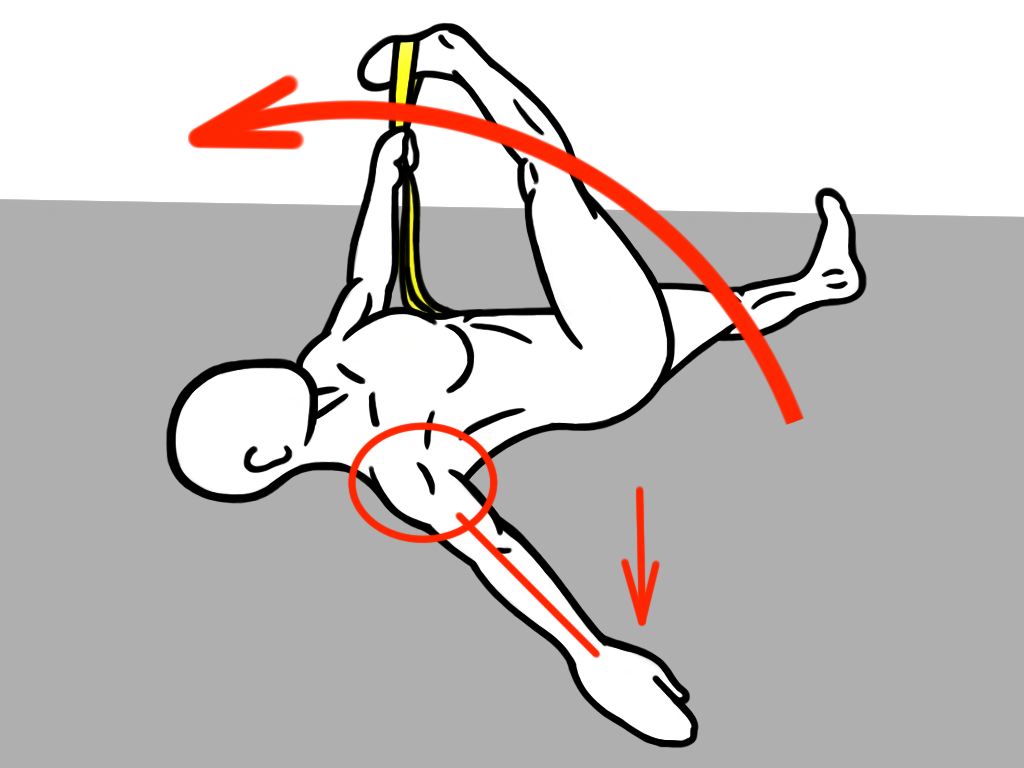
SUPINE TRANSVERSE STRETCH-
TARGET: Lateral aspect of the Glutes, Hamstrings, Quadriceps, IT Band, Calf and Foot in a Transverse (Rotational) line of action, which is greatly responsible for the pulling (backward) phase of your gait and stabilizing the planted leg while running.
POSTION: Lift one leg straight up towards the sky with a strap or towel wrapped around the arch of the foot. Pull the heel across the body and down towards the floor while you keep the same side shoulder flat on the ground. Attempt to align the foot at hip height or as close as possible in order to affect more of your soft tissue on the lateral side of your hamstrings, quadriceps and glutes.
ACTION: Contract for a 5-count with one-fourth of your strength and attempt to pull the heel back up towards the sky as you hold it in place with the strap. Next, relax for a 10-count as you hold the leg. Repeat this Contract/Relax sequence two more times and continue to hold the stretch until you can feel the muscles release.
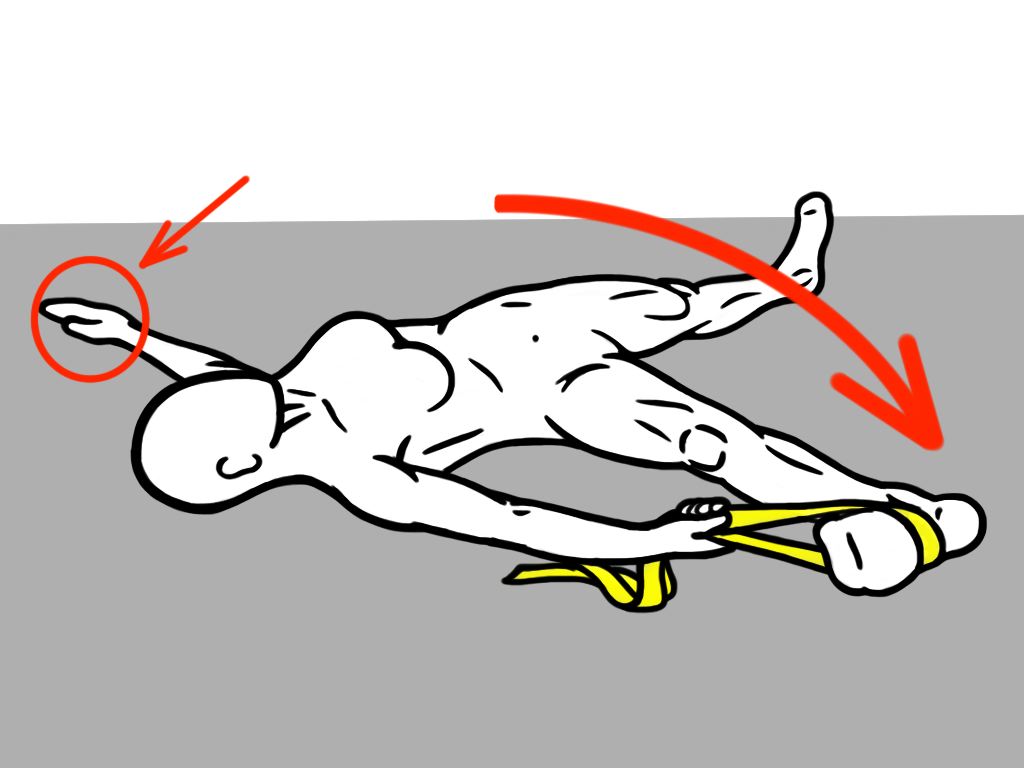
SUPINE ADDUCTOR STRETCH-
TARGET: The Medial (Inner) aspects of the Hamstrings, Quadriceps, Calf and Foot as well as the Hip Flexors and Adductors. These muscles positioned on the inner thigh and groin are partially responsible for the pulling (forward) phase of your gait and the stabilization of the planted leg.
POSTION: Lift one leg straight up towards the sky with a strap or towel wrapped around the arch of the foot. Position the heel directly over the hip socket if possible. If not, keep the leg vertically aligned with the hip socket and the shoulder.
ACTION: Contract for a 5-count with one-fourth of your strength and attempt to pull the heel up towards the sky as you hold it in place with the strap. Next, relax for a 10 count as you hold the leg. Repeat this Contract/Relax sequence two more times and continue to hold the stretch until you can feel the muscles release.

SHOULDER FLEXION AGAINST WALL
POSITION: Place both hands on the wall with the fingers pointing up.
ACTION: Drop your chest down towards the floor and push your hips away from the wall. This movement will help lengthen the lats and the chest muscles. Attempt to twist the belly of your biceps up towards the sky by externally rotating the shoulders. This movement will create even more length through the shoulders, lats and chest muscles.
Modes of Application:
Hold this position for approximately 30 seconds and focus on deep exhalations.
Optional: Hold the end position and perform several PNF Contract/Relax sequences.
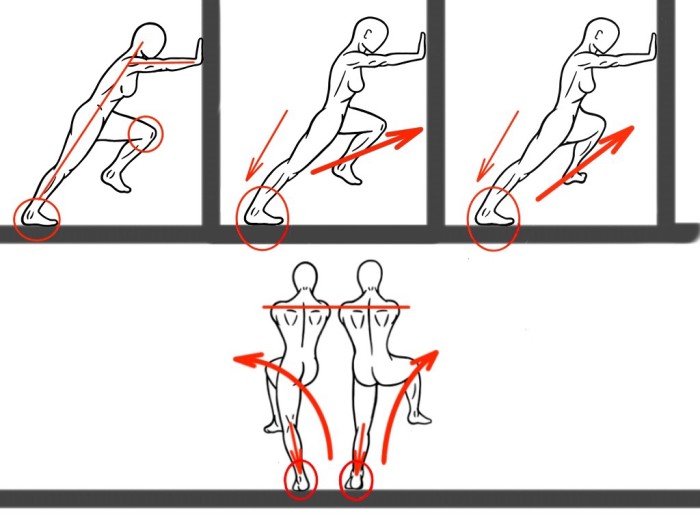
ANKLE MATRIX
This PreHab exercise uses a dynamic flow of movement to help mobilize the ankle/foot complex. It is useful in a group training when there are limitations in providing effective instructions for PNF stretching.
POSITION: Use your arms to brace your body against the wall on an angled slope with straight-line alignment from ear to hips to ankle. Slope the body approximately 30-45 degrees, but make sure that the standing heel is flush on the ground. Lift one leg off the ground and hold with a flexed position of the hip.
ACTION: As you keep the standing heel flat on the ground, drive the raised knee towards the wall in several directions: forward, right and left.
Driving the hips forward will stretch the standing calf and foot, while changing the angle of the raised knee can change the stretching emphasis on the calf and foot. Perform these movements in a smooth and controlled manner. Stay relaxed and breathe deeply. Find the directions and areas that work to release the most tension in your calf or foot and focus on those areas more.
Keep the back heel pressed into the floor throughout all of the movements. The back heel is the ankle that is being targeted. If the heel begins to lift from the floor as you drive the knee in the different directions towards the wall, it is an indication that you are tight and have restrictions in that movement pattern.

Revisit the other stretches and soft tissue therapy techniques for the calf and foot if you are not able to keep the back heel completely flat on the ground while performing this Ankle Matrix. Also, keep the shoulders square to the wall and level with the floor while performing the different variations of this stretch.
Modes of Application:
Smoothly perform several reps of this movement in each direction as you breathe deeply and relax. Next, hold this position for approximately 30 seconds as you press your knee towards the wall and keep the rear heel flat on the ground. Focus on deep exhalations.
Optional: Hold the end position and perform several Contract/Relax sequences with the targeted ankle/foot.

HIP MATRIX – LUNGE & REACH
POSITION: Kneel on the ground with 90-degree angles in both knees. Square the hips, place the hands together and lengthen the spine.
ACTION: Slide the hips forward and drive the front knee over the front toes as the arms lift and reach off to the side, rotating in the torso and the hips. Keep the hands touching and the arms straight when reaching. Pull the belly button into the spine to engage the abdominals and return to start.
Perform several reps of this movement on each side.
Pause at the bottom of the stretch or at the top and perform the PNF Contract/Relax technique with any of the muscles that feel tight or restricted.
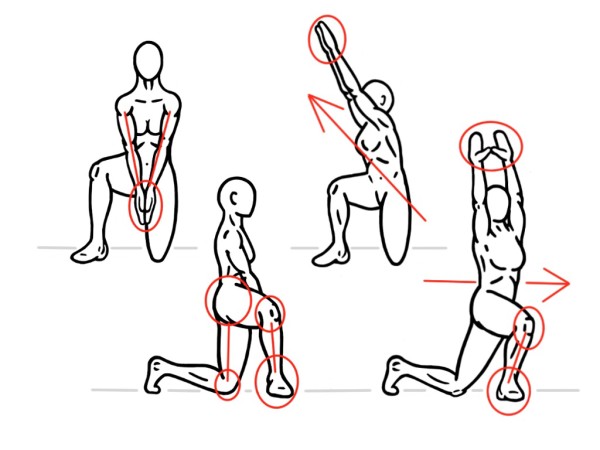
HIP MATRIX – DIAGONAL LUNGE & REACH
POSITION: Kneel on the ground with one foot placed out on a 45-degree angle. Square the hips, place the hands together and lengthen the spine.
ACTION: Slide the hips forward and drive the front knee over the front toes as the arms lift and reach off to the side, rotating in the torso and the hips. Keep the hands touching and the arms straight when reaching. Pull the belly button into the spine to engage the abdominals and repeat.
Perform several reps of this movement on each side.
Pause at the bottom of the stretch or at the top and perform the PNF Contract/Relax technique with any of the muscles that feel tight or restricted.
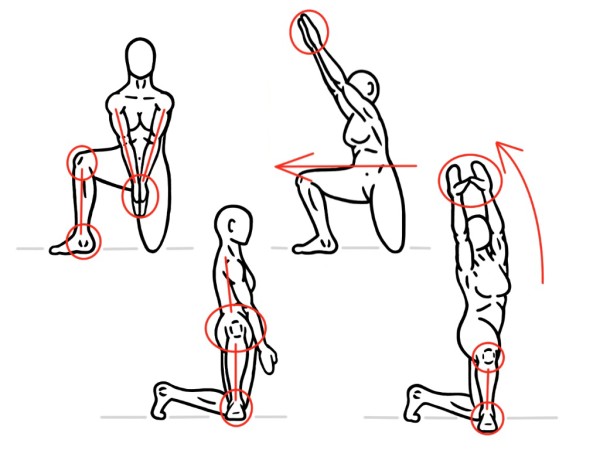
HIP MATRIX – LATERAL LUNGE & REACH
POSITION: Kneel on the ground with one foot placed out on a 90-degree angle. Square the hips, place the hands together and lengthen the spine.
ACTION: Drive the hips forward and drive the front knee over the front toes as the arms lift and reach off to the side, rotating in the torso and the hips. Keep the hands touching and the arms straight when reaching. Pull the belly button into the spine to engage the abdominals and repeat.
Perform several reps of this movement on each side.
Pause at the bottom of the stretch or at the top and perform the PNF Contract/Relax technique with any of the muscles that feel tight or restricted.

SPIDERMAN LUNGE
This mobility exercise will help to loosen up the posterior hip musculature, namely the glutes. It will also help to restore range of motion to your hip flexors, which are essential in performing squats and lunges.
POSITION: Start in a plank position with the arms in a 90-degree angle to the spine. Align the body in a straight line from head to heels and fully extend the elbows. Pull the belly button into the spine to engage the abdominals.
ACTION: Step one foot forward to the outside of the hand and align the toes and fingers in a straight line if possible. Press the floor away with the arms and keep the straight-line alignment from head to heel. Breathe deeply and relax while alternating feet on each forward-lunge step.
Modes of Application:
Hold this position for approximately 30 seconds as you mentally imagine your hip flexors lengthen and focus on deep exhalations.
Smoothly perform several reps of this movement as you breathe deeply and relax.
Hold the end position and perform several Contract/Relax sequences with the targeted hip.

SQUAT AND ROTATE
This mobility exercise will help restore the range of motion for: Hips, Thoracic Spine, Ankles, Shoulders and Posterior Chain
Use in PreHab routines for: Running, Jumping, Squatting, Pulling, Rotation, Throwing and Spinal Extension.
POSITION: Stand with feet shoulder-width apart and in neutral alignment from head to heel.
ACTION: Squat down by driving the hips backwards and bending in the knees. Keep the shins as vertical as possible and press the thighs wide to create room for the torso and hips to lower down. Extend the arms backwards and reach the fingers towards the horizon while lifting the chest and lengthening the spine.
Next, drive into the heels and stand up while reaching one arm up and over the opposite shoulder. Push the hips forward as you stand and pull the belly button in towards your spine to engage the abdominals and stabilize the core. Rotate through the shoulders as you lift one arm up and reach over the opposite shoulder. Reach the fingers back towards the horizon and lengthen through the entire body as much as possible.
Pivot on the big toe of the foot on the same side as the reaching arm. Rotate the hips and turn the knee in towards the middle as you peel the heel up off the ground. Create an internal rotation in the hip socket and press the balls of the foot into the ground. Reach and lengthen as far as possible and then return to standing before performing the entire sequence to the other side of the body.
Perform several reps on each side in a smooth, controlled and relaxed manner.
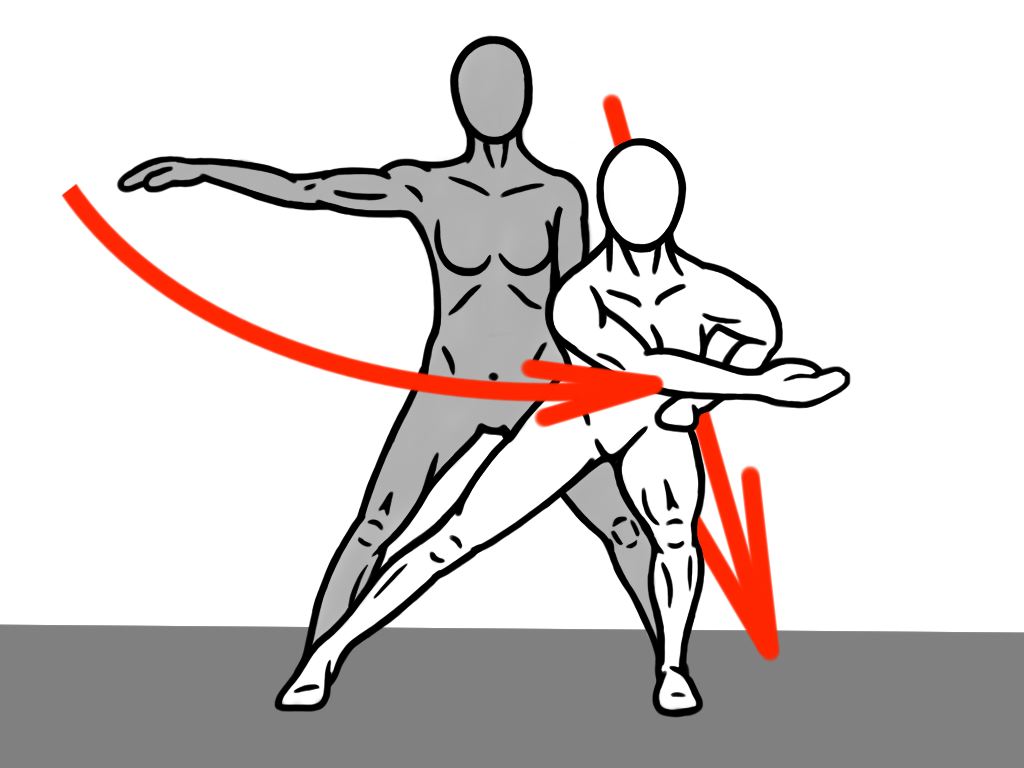
LATERAL LUNGE AND REACH
This mobility exercise will help restore the range of motion for: Posterior Chain, Ankle, Hip, Thoracic Spine and Shoulders
Useful in PreHab routines for: Running, Agility, Jumping, Squatting, Hip Hinging (Deadlifts), Lunges and Throwing.
POSITION: Extend your arms out to the side and parallel to the ground to measure your foot position. Step each foot out and vertically align them with your elbows. Next, turn both feet parallel with one another and point the toes forward.
ACTION: Bend on one leg and slide the hips backwards and to that side as you reach an arm forward. Press the hips back towards the horizon as you bend your knee. Attempt to align the shoulder, hip, knee and ankle of the lunging side all in the same vertical plane. Use a mirror or a partner to spot you on this alignment.
Next, press your foot into the ground and drive your hips forward to return to the starting position.
Perform several reps of this movement on each side with each arm.
Pause at the bottom of the stretch or at the top and perform the PNF Contract/Relax technique with any of the muscles that feel tight or restricted.
________________________________________________________
Start practicing Soft Tissue Therapy with Foam Rolling – CLICK HERE
To learn more about Soft Tissue Therapy – CLICK HERE
To learn more about Stretching -CLICK HERE
Original article and pictures take www.prehabexercises.com site
Комментариев нет:
Отправить комментарий